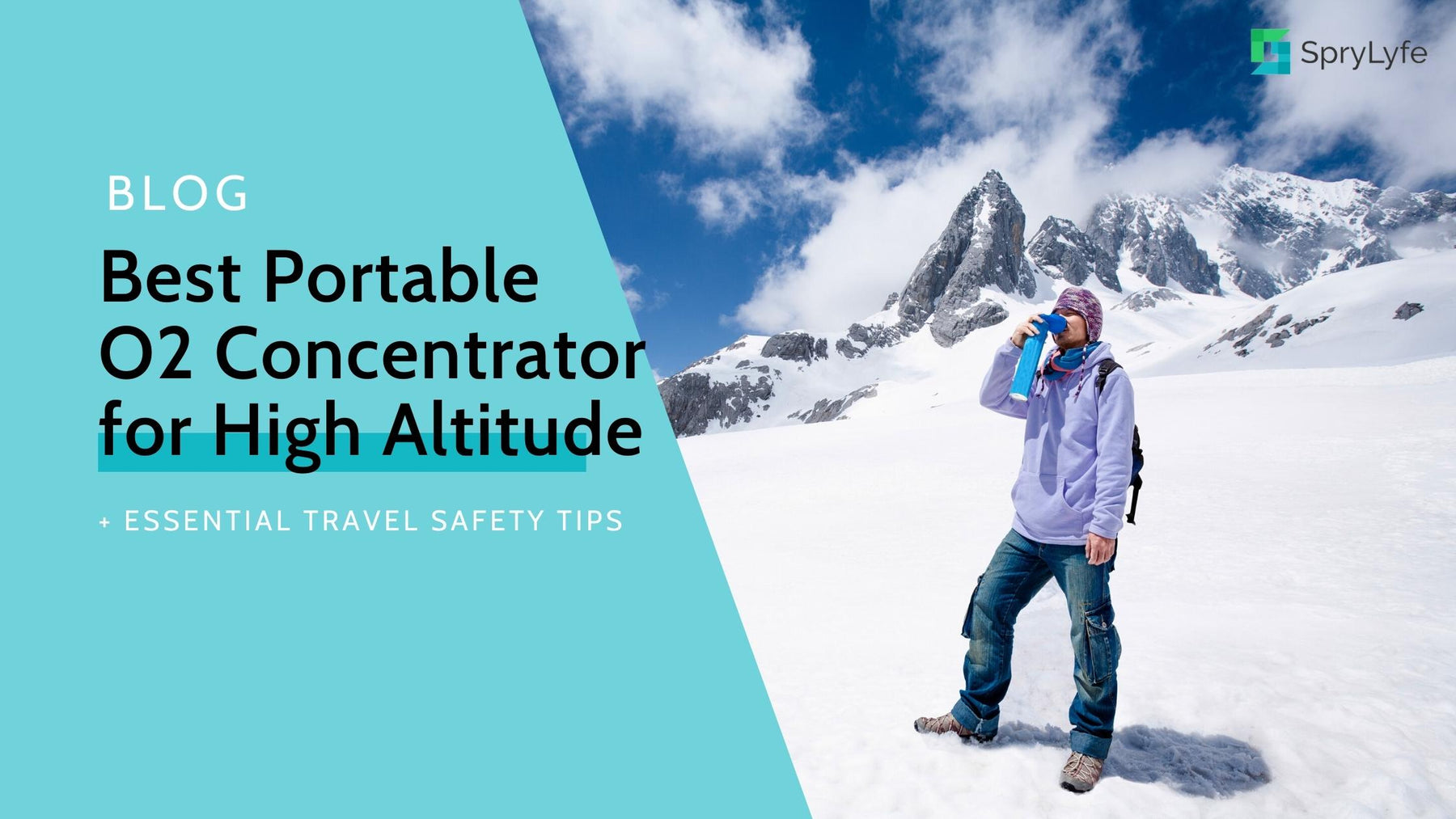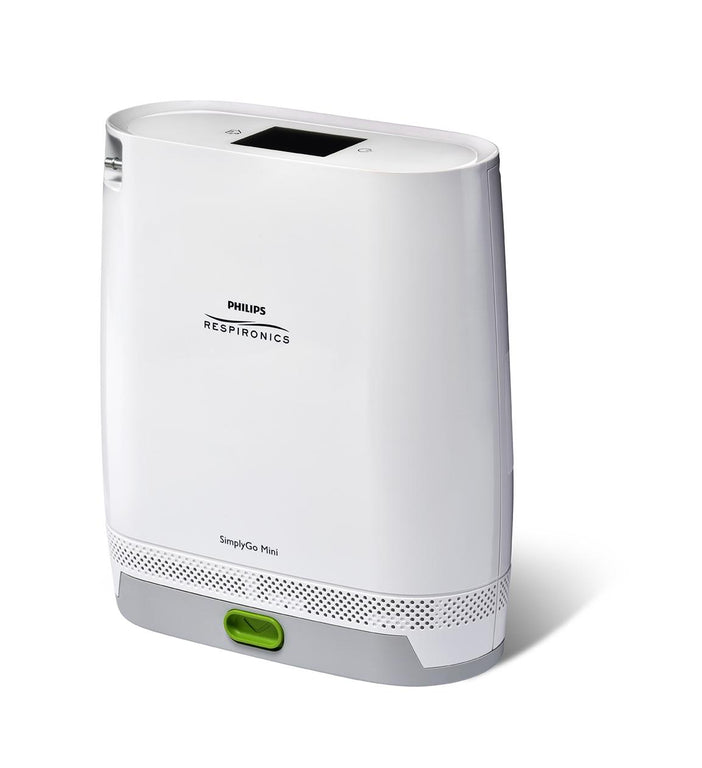
5 Best Portable Oxygen Concentrators for High Altitude (2022 Guide)
When traveling to high altitude locations, it's important to have a portable oxygen concentrator with you in case of an emergency. Without a portable oxygen concentrator for high altitude, you may find yourself struggling to breathe at high altitudes. This can be dangerous and even life-threatening in some cases.
In this article, you will discover how a portable O2 concentrator can help you when you are at high altitudes. We will also show you how to use a portable oxygen concentrator when at high altitude and introduce you to the best portable concentrators for sale for this purpose.
Importance of Using Portable Oxygen for High Altitude
It is very important to have a portable oxygen concentrator that provides enough oxygen, especially if you have COPD (Chronic Obstructive Pulmonary Disease) or other respiratory disease. Even an acute mountain sickness can be very serious for you since it can cause exacerbations and low blood oxygen levels.
Portable oxygen concentrators work by taking in air and separating the oxygen to give you concentrated amounts.
In addition, it is also better to plan ahead of your trip, to allow your body to acclimate to the change of altitude. Also, take note that any activity that you do, like skiing or hiking, will increase your breathlessness. Aside from being extra cautious, bring with you a medical grade portable oxygen concentrator.
What You Should Know About Oxygen Supply at High Altitude

Any location at 8000 to 12 000 feet above sea level is considered a high altitude. Many people who ascend to locations at high altitudes experience altitude sickness which usually begins 6 to 48 hours after the exposure.
Traveling by plane also exposes you to extremely high altitudes as a plane usually flies at 31 000 to 38 000 feet. It is why the majority of the passengers suffer from altitude sickness. It is even harder for those who have respiratory disorders.
The percentage of oxygen in the air you breathe is constant at different altitudes. However, the decrease in atmospheric pressure at higher altitudes can affect the gas exchange in your lungs and can cause faster breathing.
Check out this table that shows the oxygen levels at various altitudes. Notice how the percentage lowers as the altitude becomes higher.
|
Altitude (feet) |
Effective Oxygen Percentage |
Altitude Category |
|
0 feet |
20.9 % |
Low Altitude |
|
1000 feet |
20.1 % |
Low Altitude |
|
2000 feet |
19.4 % |
Low Altitude |
|
3000 feet |
18.6 % |
Moderate Altitude |
|
4000 feet |
17.9 % |
Moderate Altitude |
|
5000 feet |
17.3 % |
Moderate Altitude |
|
6000 feet |
16.6 % |
Moderate Altitude |
|
7000 feet |
16.0 % |
Moderate Altitude |
|
8000 feet |
15.4 % |
High Altitude |
|
9000 feet |
14.8 % |
High Altitude |
|
10,000 feet |
14.3 % |
High Altitude |
|
11,000 feet |
13.7 % |
High Altitude |
|
12,000 feet |
13.2 % |
High Altitude |
|
13,000 feet |
12.7 % |
Very High Altitude |
|
14,000 feet |
12.3 % |
Very High Altitude |
|
15,000 feet |
11.8 % |
Very High Altitude |
|
16,000 feet |
11.4 % |
Very High Altitude |
|
17,000 feet |
11.0 % |
Very High Altitude |
|
18,000 feet |
10.5 % |
Extreme High Altitude |
|
19,000 feet |
10.1 % |
Extreme High Altitude |
|
20,000 feet |
9.7 % |
Extreme High Altitude |
|
21,000 feet |
9.4 % |
Extreme High Altitude |
|
22,000 feet |
9.0 % |
Extreme High Altitude |
|
23,000 feet |
8.7 % |
Extreme High Altitude |
|
24,000 feet |
8.4 % |
Extreme High Altitude |
|
25,000 feet |
8.1 % |
Extreme High Altitude |
|
26,000 feet |
7.8 % |
Ultra-High Altitude |
|
27,000 feet |
7.5 % |
Ultra-High Altitude |
|
28,000 feet |
7.2 % |
Ultra-High Altitude |
|
29,000 feet |
6.9 % |
Ultra-High Altitude |
What is Altitude Sickness?

If you just moved to an area with high altitude, or you just boarded a plane, and you suffer from some form of lung disease then you may be experiencing altitude sickness. It is also referred to as "mountain sickness" which is triggered when you climb or walk to a higher altitude, or elevation, too quickly.
Symptoms of altitude sickness include headache, dizziness, nausea, vomiting, fatigue, loss of energy, shortness of breath, trouble sleeping, and loss of appetite. These symptoms usually start to appear within 12 to 24 hours after you reach a higher elevation. You will get better usually within a day or two as your body adjusts to the altitude change.
There are three levels of altitude sickness:
Acute Mountain Sickness (AMS)
This is the mildest and most common form of altitude sickness. Its symptoms almost feel like a hangover and include headache, dizziness, nausea, and muscle aches.
High-altitude Pulmonary Edema (HAPE)
This refers to a buildup of fluid in the lungs that is very dangerous and can be life-threatening. HAPE is the most common cause of death due to altitude sickness.
High-altitude Cerebral Edema (HACE)
This is the most severe form of altitude sickness and occurs when fluid enters the brain. It is also life-threatening, so you should seek medical help right away.
Anyone can experience altitude sickness, no matter how fit you believe you are. However, your chance of getting it depends on how quickly you move to a higher altitude, how high you go, and other factors.
Why High Altitude Oxygen Access is Vital

Having a source of oxygenated air is essential for people with respiratory problems who move to a higher elevation. The lack of oxygen can cause problems not just to your lungs, but also to your heart, brain, and blood.
When at higher elevations, you may experience an increased heart rate. However, after some time, your heart will beat at a normal pace and will work remarkably well.
The state of not having oxygen in sufficient amounts at the tissue level in order to maintain homeostasis, also called hypoxia, has progressive effects on the central nervous system. Accidents occurring at extreme altitudes like mountains have chances of being caused by hypoxic depression of cerebral function brought about by oxygen deprivation.
Initially, when traveling to a higher altitude, your hemoglobin concentrations rise through a fall in the volume of plasma because of dehydration. The increase in blood viscosity with increased coagulability will cause a higher risk of stroke.
Can Portable Oxygen Concentrators be Used at High Altitudes?

There are portable oxygen concentrators that you can use when you are at high altitudes. POCs are essential to avoid unfortunate health conditions and also to provide you with the supplemental oxygen that you need.
Although oxygen tanks are available for use, they are difficult to carry with you when you travel. It is why portable oxygen concentrators are very convenient and useful for your health concerns when moving to higher elevations.
Who Needs a Portable Oxygen Concentrator at High Altitudes?
Although anyone, even an athlete, is at risk of altitude sickness, people who suffer from respiratory disorders have higher chances of experiencing it. Here are some of the respiratory conditions that will require you to bring with you a portable oxygen concentrator, especially at high altitudes.
Chronic Obstructive Pulmonary Disease (COPD)

People with COPD have a higher risk of developing altitude-related symptoms than normal people. To reduce the risk of adverse effects, COPD patients must avoid strenuous exercise at high altitudes and ensure optimal health prior to ascending.
Bronchial Asthma

A change in altitude can influence bronchial hyperresponsiveness, and thus develop a likelihood of an acute asthma attack. At altitudes above 2500m, conditions may pose a higher risk of an asthma attack, thus it is best to have a portable oxygen concentrator.
Obstructive Sleep Apnea

OSA happens when the muscles in the back of your throat relax too much that it hinders normal breathing. Portable oxygen concentrators will be helpful to people with OSA as oxygen administration has been used as an alternative treatment for patients.
Pleural Interstitial Lung Disease

Patients with interstitial lung disease with the presence of pulmonary hypertension should bring supplemental oxygen and nifedipine for HAPE prophylaxis. Also, you should wait for a minimum of two weeks following the resolution of pneumothorax before ascending to a high altitude, including commercial air travel.
Also, if you are hiking at very high altitudes and traveling by plane at high altitudes, it is recommended that you bring a portable oxygen concentrator, especially if you have respiratory issues.
5 Best High Altitude Portable Oxygen Concentrators
1. Philips Respironics SimplyGo Portable Oxygen Concentrator
The Philips Respironics SimplyGo portable O2 concentrator can work at altitudes up to 10,000 feet. It has both pulse and continuous flow modes for a versatile therapy. It also includes a mobile cart and a carry case for portability and convenience that you can bring with you anywhere.
2. Philips Respironics SimplyGo Mini Portable Oxygen Concentrator
Phillips Respironics SimplyGO Mini is a more compact and lightweight option for a portable oxygen concentrator. It is an FAA-approved unit that works at altitudes up to 10,000 feet and can also operate for up to 4.5 hours using the included standard battery.
For longer trips, you can purchase an extended battery that can last for up to 9 hours. The Philips Respironics SimplyGO Mini also delivers oxygen in up to 5 pulse dose settings.
3. Inogen One G4 Portable Oxygen Concentrator
The Inogen One 4 portable oxygen concentrator is one of the lightest units that you can carry anywhere. It only weighs less than 2 pounds including the standard battery.
This small but terrible device can deliver pulse mode flow rates. Inogen One 4 portable oxygen concentrator works well for 5 hours at up to 10,000 feet.
4. Inogen One G5 Portable Oxygen Concentrator
Inogen One G5 offers the highest oxygen per pound among the portable oxygen concentrators available in the market today. It has a compact and lightweight design that provides varying flow settings from 1 to 6 and is also designed to function for 24 hours.
It is the best unit to dramatically increase your independence. This portable oxygen concentrator’s interface was designed with easy-to-read LCD displays and comes with simple control functions.
5. SeQual Eclipse 5 Portable Oxygen Concentrator
The SeQual Eclipse 5 portable oxygen concentrator is a single-oxygen solution, proven, and reliable that is equipped with 24/7 capabilities. With a height of just two feet, this easy-to-transport oxygen concentrator functions fully on DC power, with an ability to recharge.
It can provide continuous flow settings of up to 3 liters per minute and pulse dose settings from 1 to 9. SeQual Eclipse 5 portable oxygen concentrator can function at up to 10,000 feet of altitude.
Tips When Using Oxygen Concentrators at High Altitudes
Even if you think you have to carry the most reliable and most effective portable oxygen concentrator with you, there are still some tips you have to consider. Here are some things you have to take note of before you travel to higher elevations.
Let your doctor know about your trip

Make sure to inform your doctor of your travel plans. Your doctor may give you recommendations on the flow adjustment on your portable oxygen concentrator in order to accommodate the change in altitude.
Never decide to just guess your flow adjustment on yourself. Your physician knows exactly the best way to modify your oxygen therapy.
Make sure your portable oxygen concentrator is FAA-approved

Before taking any portable oxygen concentrator with you, make sure that it is approved by the FAA. The Federal Aviation Administration requires that all passengers who need to have oxygen therapy in flight bring devices that are FAA approved.
After making sure that your portable oxygen concentrator has FAA approval, it is best that you contact your airline ahead of time. Confirm any requirements that they may have (like a copy of your medical necessity prescription) for allowing your unit on board.
Check the maximum altitude capacity of your oxygen concentrator
Before boarding a flight or traveling to elevations 13,123 feet high from the ground, ensure that you check the maximum altitude of your device. Some portable oxygen concentrators can only perform at up to 10,000 feet high altitudes, so get one with higher altitude capacity.
Failure to check the capacity may result in problems and might put your health at risk. It is best to get a portable oxygen concentrator with the highest altitude capacity to be sure.
Keep your portable oxygen concentrator charged

Portable oxygen concentrators can only function for a few hours generally. It is very important to make sure your device is fully charged before taking it with you on a long trip, so you can have enough oxygen when sleeping or traveling.
It is also best if you pack spare batteries in your bag together with the other necessities. If traveling by car or driving with oxygen, you can charge your portable oxygen concentrator as you go, so that the battery will never run out and you can still use your fully charged device after getting out of your car.
FAQs About Using Portable O2 Concentrators at High Altitude
Do portable oxygen concentrators work in high altitudes?
Yes, portable oxygen concentrators work in high altitudes. However, different units have different maximum altitude capacities.
Through this life-changing device, you can still board a flight and travel to higher elevations. You won't have to worry about compromising your oxygen therapy. Even at high altitudes, oxygen concentrators are a safe alternative to liquid or compressed oxygen in oxygen tanks.
Does portable oxygen help with altitude sickness?
Yes, portable oxygen concentrators actually help with altitude sickness. If you are experiencing symptoms of AMS, you can use supplemental oxygen to reduce the symptoms.
You can also use a portable oxygen concentrator overnight to help you sleep easier and prevent symptoms of altitude sickness. At extreme altitudes, supplemental oxygen can be helpful in preventing the severe effects of hypoxia.
Can you buy oxygen for high altitudes?
Yes, there are various devices of supplemental oxygen that you can buy for high altitudes. There are different models of portable oxygen concentrators that you can choose from.
For altitude sickness, there are also over-the-counter oxygen systems that feature a single tank available on the market. Such a device does not need a prescription and is usually used by athletes.
Are oxygen concentrators allowed on airplanes?
Yes, portable oxygen concentrators are allowed on board as long as it is approved by the FAA. It is also better to let your airline know prior to your flight in order to confirm the requirements.
There are certain portable oxygen concentrators permitted for aircraft use. Inogen One, Airsep Lifestyle, and Sequal Eclipse are some of the units that meet the Federal Aviation Administration Requirements. You can see the complete list of requirements here.

Where to Buy a Portable Oxygen Concentrator High Altitude?
Using a portable oxygen concentrator has many benefits for someone with breathing problems. Having enough oxygen supply when at high altitudes is only one of them.
Now that you know the proper use of a portable oxygen concentrator for high altitudes, you can go on trips to higher elevations safely. It has been proven that such a device is helpful in providing the supplemental oxygen that patients need, especially on airplane travel.
It is always best to have a comprehensive consultation with your doctor before deciding on what concentrator specs to buy.
If you’re not sure what to buy, check out these handy guides to get you started:
- If you’re looking for affordable models: Cheapest portable oxygen concentrators
- If you’re looking for a lightweight device: Lightest portable oxygen concentrators
- If you’re looking for a quiet unit: Most quiet portable oxygen concentrators
- If you’re looking for something that’s easy to carry: Smallest portable oxygen concentrators
- If you don’t know how to choose, read our guide on how to select a portable oxygen concentrator for your every need







Leave a comment